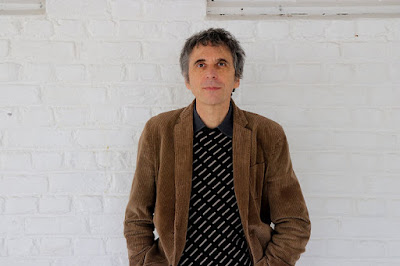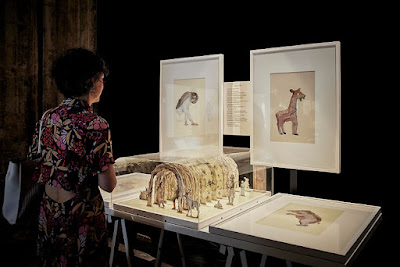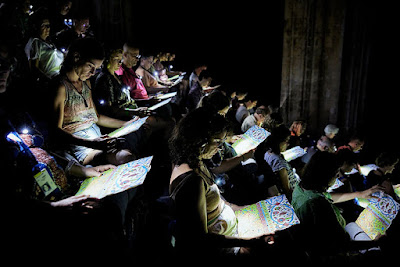conversations in ten questions 58 : Patrick Corillon
© Christophe Raynaud de Lage
The 77th edition of the Festival d'Avignon, one of the most important performing arts festivals in the world, took place from 5th to 25th July. The programme of this first edition, prepared by the Portuguese actor, director, playwright and producer Tiago Rodrigues (1977), who was appointed director of the Festival for four years, included 44 performances. The first of the conversations that we had with the artists of the performances we saw between 6th and 10th July at this year's edition was with Belgian contemporary artist and storyteller Patrick Corillon (1959). Corillon (1959) took part in the festival with his show 'Portrait de l'artiste en ermite ornemental' (Portrait of the artist as an ornamental hermit).
After studying at the Institut des Hautes Études en arts plastiques in Paris, Corillon decided to focus on travelling and on a practical experience of art through installations, scenographies, sculptures, book publishing, film directing, and live performances. Corillon is represented by the gallery In Situ Fabienne Leclerc in Paris and produces his work at Le Corridor, run by actress and director Dominique Roodthooft, an accomplice who, like him, likes to playfully invite the audience to construct thoughts.
Corillon shared two stories, 'L’appartement à trous' (The Flat with Holes) and 'Le Voyage de la Flaque' (The Journey of the Puddle), in the show we watched on that day. The artist presented different pairs of stories on different performance dates.
In 'L’appartement à trous,' Corillon narrated the discovery of the mythical nature of languages through the eyes of a curious child - a reflection of the artist's own childhood. For instance, Polish being the language of the leaves and English the language of the stones. Through this enchanting journey, we explored the meanings and sounds of words, while also delving into the child's loss of his father and his relationship with cats. On stage, Corillon began to share his story, stating that as a performer, the timing of his speech might not be entirely suitable for the stage. We followed not only his words but also his magical creation of new worlds using his drawings and home-made multi-functional table made from simple materials, constantly transforming into something else. It was impossible not to recall William Kentridge, who, despite being originally recognized in the field of visual arts, captivated the Istanbul audience as a storyteller and stage performer during the 2011 idans festival, and not to find elements reminiscent of Kentridge in Corillon's performance.
In the second story Corillon shared, 'Le Voyage de la Flaque,' we took our places on opposite platforms with tribunes installed. We became both listeners and performers of the narrated story. We wore specially designed lanterns hanging on both sides of our necks and placed handcrafted large paper disks with the artist's drawings on our laps. While listening to the story narrated by a storyteller woman at the microphone on the stage, we also manipulated the different elements on the disk on our laps, rotating small disks to create the visual world of the story, and illuminated it the way we wanted, as if creating small stages on our laps. In this journey of the story, the form of which Corillon mentioned was adapted from an Eastern tradition, we listened to the struggle for existence of a small puddle, plunging into vast seas and facing black wolves trying to devour it. With our own actions, we explored the visual world of the story and experienced the journey.
Ayşe Draz & Mehmet Kerem Özel
Portrait de l'artiste en ermite ornementale, 2023 © Christophe Raynaud de Lage
What is the essence of performance in your opinion?
It means realising that the imagination is not there to help us escape from or console ourselves with the real world, but rather to place it in a broader perspective, to place the present in the context of the long term.
Do you believe in the transformative power of art? How?
I believe in it deeply, for the reason I gave in the first question.
When you are working on a new piece, what sources inspire you? Do dreams play a role in your works?
Yes, it all comes from my unconscious, although I'm well aware that our unconscious is shaped as much by our deepest nature as by thousands of years of living in society.
When do you decide to give a title to a piece you are working on if it already does not have one?
I give a title in the same way that a painter signs one of his paintings; for me it's a way of saying that the project is finished.
Is there any writer, artist or person whom you think influenced your art most? And if there is such a figure, who?
Marcel Proust and Robert Louis Stevenson.
When you consider the current state of the world in every sense, what is the most important and urgent issue for you as an artist?
Giving meaning. Just as much for the biggest events as for the smallest; knowing that when you give, you don't have to receive in return.
What does being part of the Avignon Theatre Festival signify for you?
It's recognition for the work we do and a chance to meet new people.
In the creating process of your piece 'Portrait de l'artiste en ermite ornemental,' what and/or who were you inspired and influenced by?
I was inspired by Wiliam Morris, the creator of Arts and Crafts, who considered the decorative arts to be arts in their own right, and who took into account the working conditions of each of the craftsmen who worked with him to make his objects; so much so that he was the founder of the Scialist League in England.
What are your thoughts on audience participation in performing arts?
In the projects I propose in Avignon, the spectators are also full actors, because they handle game boards at the same time as they discover the show. I try to strike a balance between being both an actor and a spectator in the world.
Can you talk a little bit about the role of place in the formation of your pieces?
All the projects are created in my bed during sleepless nights. That's the real place of creation. Afterwards, the objects are built in different places, but I always try to preserve their phantasmagorical character.
[The Turkish version of this conversation was published in unlimited.]








Very NIce
ReplyDelete